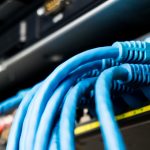
Fiber Optics for Cities
As the backbone of internet connectivity, fiber optic networks play a crucial part in business growth and personal enjoyment. While individual businesses are investing in deploying fiber cabling for their location, some cities are choosing to invest in city-wide networks. Learn how this can impact the future of connectivity and fiber optics by dramatically increasing internet speeds.
What are Fiber Optic Networks?
Fiber cables use pulses of light transmitted through strands of glass to exponentially increase network speeds. Compared to traditional wiring and cable, fiber optics is an incredibly efficient way to boost speeds and connect devices, both locally and through the internet.
In the digital age, an increase in internet speed can translate into a direct increase in profits for a business. As more companies rely on online services and innovative software, faster internet speeds can increase productivity and allow employees to tackle more projects in less time.
Installing a City-Wide Network
There are a number of obstacles cities need to overcome in order to create a city-wide network of fiber optic cables. First, these cables are more costly and fragile than traditional wiring. Whether installed on existing utility poles or buried, these cables can easily become damaged.
Additionally, creating a city-wide network typically requires extensive burying techniques. Some companies use a technique called micro-trenching, which creates a small trench for the cable. This is often necessary in cities, as the existing utilities create a maze of underground pipes, wires and other obstacles.
Even with all of the ambitious projects happening in cities all over the world, there are many places that are still far away from fiber optic connectivity. For these remote areas, wireless internet connectivity is another area of exciting growth. Wireless internet is also rapidly increasing in strength, speed, and availability.
Benefits of Expanded Fiber Optic Networks
In some areas, the internet speed could increase by as much as 1,000 times with the installation of fiber optics. Fiber cables are incredibly efficient compared to many other systems, however, many cities are still relying on inefficient processes to send and receive information. Creating a city-wide network could increase efficiency in every business and home office, as well as city government offices.
The amount of data able to pass through fiber optics is nearly limitless. However, long distances require amplification. After approximately 40 to 60 miles of fiber optics, cities must invest in in-line amplification shelters, or ILAs. An ILA requires a significant investment to construct and maintain, particularly if the intended city-wide network is a great distance away from the current network of fiber optics.
In the past, large companies like Google sought to expand fiber optic networks across a number of cities. These ambitious projects were eventually set aside in favor of a business-by-business model. Some fiber optic companies, however, are now considering relaunch projects with the lofty goal of expanding fiber optic networks completely across a number of cities.
The Future of Fiber Optics
Fiber optics is an exciting, new technology that continues to improve. Although the challenges of laying a physical fiber cable can make it costly and require creative deployment strategies, cities and businesses alike are looking for ways to expand the network and connect their locations.
With every new city, business, or home connected, fiber optics continues to show how increased internet connectivity can allow a community to flourish. Look for fiber optics in your area, or find out how you can get your location connected to improve your access to cutting-edge connectivity. Don’t let your business fall behind or spend hours a day waiting for pages to load at home due to slow internet. Take a step into the future with the latest fiber optics and wireless internet technologies.
Check out our last post: 5 Ways Fiber Optic Cable is Better





No Comments